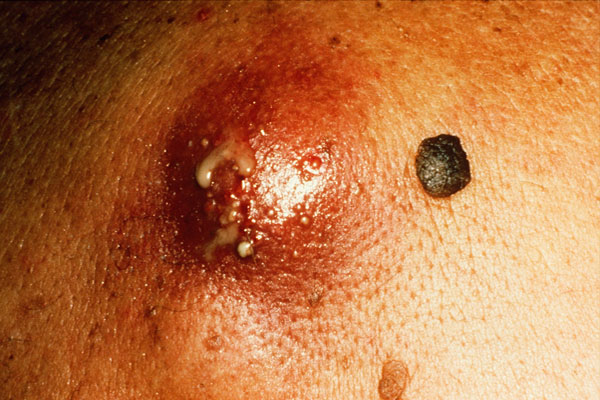Bacterial skin and skin structure infections (BSSSI) encompass a broad spectrum of infections affecting the skin and its underlying tissues. These conditions can range from mild and localized to severe and life-threatening, necessitating timely diagnosis and appropriate treatment. This article provides an in-depth overview of bacterial skin infections, including their causes, symptoms, types, diagnostic approaches, and treatment options.

What are Bacterial Skin and Skin Structure Infections (BSSSI)?
Bacterial skin and skin structure infections refer to infections that primarily involve the skin and its adjacent tissues, including fat, muscle, and fascia. These infections are typically caused by pathogenic bacteria that invade the skin through breaks, cuts, or other forms of skin disruption. BSSSI can be classified based on the depth of tissue involvement, the bacteria responsible, and the clinical manifestations observed.
Types of BSSSI
There are several types of bacterial skin and skin structure infections, including:
- Cellulitis: A common, superficial infection of the skin and soft tissues caused primarily by Streptococcus or Staphylococcus bacteria. Cellulitis typically manifests as red, swollen, and painful skin, often with fever.
- Skin Abscesses: A localized collection of pus beneath the skin surface, usually resulting from Staphylococcus aureus infection. Abscesses can vary in size and may require drainage.
- Erysipelas: A form of superficial skin infection most often caused by Streptococcus pyogenes. Erysipelas affects the epidermis and upper dermis, leading to distinct, raised, and erythematous lesions.
- Impetigo: A highly contagious bacterial infection typically seen in children, caused by Streptococcus or Staphylococcus bacteria. Impetigo is characterized by honey-colored crusts on red, inflamed skin.
Causes of Bacterial Skin and Skin Structure Infections
Skin Structure Infections occur when bacteria enter the skin through a breach, which may be the result of cuts, scrapes, burns, or surgical incisions. The most common bacteria involved in BSSSI are:
- Staphylococcus aureus: This bacterium is responsible for many skin infections, including abscesses, cellulitis, and impetigo. Methicillin-resistant Staphylococcus aureus (MRSA) strains have emerged as resistant to standard antibiotics, complicating treatment.
- Streptococcus pyogenes: This pathogen causes infections such as cellulitis and erysipelas, often manifesting with distinct, raised lesions.
- Pseudomonas aeruginosa: Although less common, Pseudomonas can cause infections, particularly in immunocompromised patients or those with chronic conditions like diabetes.
- Escherichia coli: E. coli infections can occasionally affect the skin, particularly in the context of perineal or abdominal infections.
Risk Factors for Bacterial Skin Infections
Several factors increase the risk of developing bacterial skin infections, including:
- Weakened Immune System: Conditions like diabetes, HIV, or cancer treatment can impair the body’s ability to fight off infections.
- Chronic Skin Conditions: Diseases like eczema, psoriasis, or dermatitis can create an ideal environment for bacteria to thrive.
- Poor Hygiene: Inadequate personal hygiene can lead to skin damage, increasing the risk of bacterial entry.
- Invasive Medical Procedures: Surgery, catheter insertion, or other medical interventions that breach the skin barrier can expose individuals to infection.
- Age: The elderly, particularly those with compromised skin integrity, are at a higher risk for developing BSSSI.
Symptoms of Bacterial Skin Infections
The clinical presentation of a bacterial skin infection can vary depending on the type and severity of the infection. Common symptoms include:
- Redness: Inflamed skin is often red, hot to the touch, and swollen.
- Pain or Tenderness: Infected areas tend to be painful, especially when pressure is applied.
- Fever: Many bacterial skin infections cause systemic symptoms such as fever, chills, and malaise.
- Pus or Drainage: In abscesses, pus may drain from the affected area, and there may be a noticeable bump or fluctuation under the skin.
- Blisters or Crusts: Conditions like impetigo result in characteristic honey-colored crusts.
Diagnosis of Bacterial Skin Infections
Diagnosing bacterial skin and skin structure infections typically involves a physical examination and, in some cases, laboratory tests. A healthcare provider may look for the following signs:
- Visual Examination: The appearance of the skin, including redness, swelling, and the presence of blisters or abscesses, can provide clues about the infection’s nature.
- Wound Culture: A sample of pus or drainage from an abscess or wound may be cultured to identify the specific bacteria causing the infection.
- Blood Tests: In severe cases, blood tests may be performed to check for systemic infection, especially in cases of cellulitis or septicemia.
Treatment of Bacterial Skin and Skin Structure Infections
The treatment of bacterial skin infections varies depending on the severity and type of infection, as well as the pathogen responsible. Common treatment approaches include:
1. Antibiotics
- Oral Antibiotics: Mild to moderate infections are often treated with oral antibiotics. Common choices include cephalexin, dicloxacillin, or clindamycin.
- Intravenous Antibiotics: Severe infections, or those caused by antibiotic-resistant bacteria like MRSA, may require intravenous antibiotics such as vancomycin or linezolid.
2. Drainage of Abscesses
In the case of skin abscesses, drainage is often necessary. This can be performed through a minor surgical procedure to release the pus, allowing the area to heal.
3. Supportive Care
- Pain Management: Over-the-counter pain relievers like acetaminophen or ibuprofen can help reduce pain and inflammation.
- Wound Care: Proper wound cleaning and dressing changes are essential to prevent further infection and promote healing.
4. Surgical Intervention
In rare cases, extensive infections that affect deeper layers of tissue may require surgical intervention to remove infected tissue or drain large abscesses.
Prevention of Bacterial Skin Infections
While bacterial skin infections cannot always be prevented, certain precautions can reduce the risk:
- Good Hygiene: Regular hand washing, showering, and cleaning wounds promptly can help prevent infection.
- Proper Wound Care: Covering cuts, scrapes, and burns with clean, sterile dressings can protect against bacterial entry.
- Avoiding Contact with Infected Individuals: BSSSI can be contagious, especially in cases of impetigo or cellulitis. Avoiding close contact with infected individuals helps reduce transmission.

